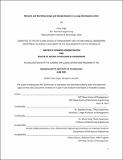Network and Workflow Design and Standardization in a Large Distribution Center
Author(s)
Frigo, Clare
DownloadThesis PDF (916.8Kb)
Advisor
Graves, Stephen
Yang, Maria
Terms of use
Metadata
Show full item recordAbstract
The retail industry is experiencing exploding growth in the digital segment and a shift in consumer delivery expectations. While distribution networks and the individual facilities were constructed to fulfill demand for the wholesale and retail channels, this growth is requiring companies to evaluate their network and facility operations to meet digital demand speed that consumers have come to expect. This thesis evaluates both the overall network design and the variability within daily operations that impact overall speed to customer.
Optimization was used to evaluate the overall distribution network. The demand distribution was used to determine where to place facilities, which channels to ship from each facility, and where to ship product from to minimize transportation costs, transportation time to customer, and improve sustainability. The optimization reviews these key metrics for different potential network scenarios that could be implemented to improve the network.
Within the distribution centers, variability in incoming orders causes variability in the time required to complete batches of orders (waves) before shipping them out. A model was developed based on standard times and wave data to capture real-time variability. This model can be used in conjunction with cross training to smooth the work across the major work areas and improve overall predictability.
Date issued
2021-06Department
Massachusetts Institute of Technology. Department of Mechanical Engineering; Sloan School of ManagementPublisher
Massachusetts Institute of Technology